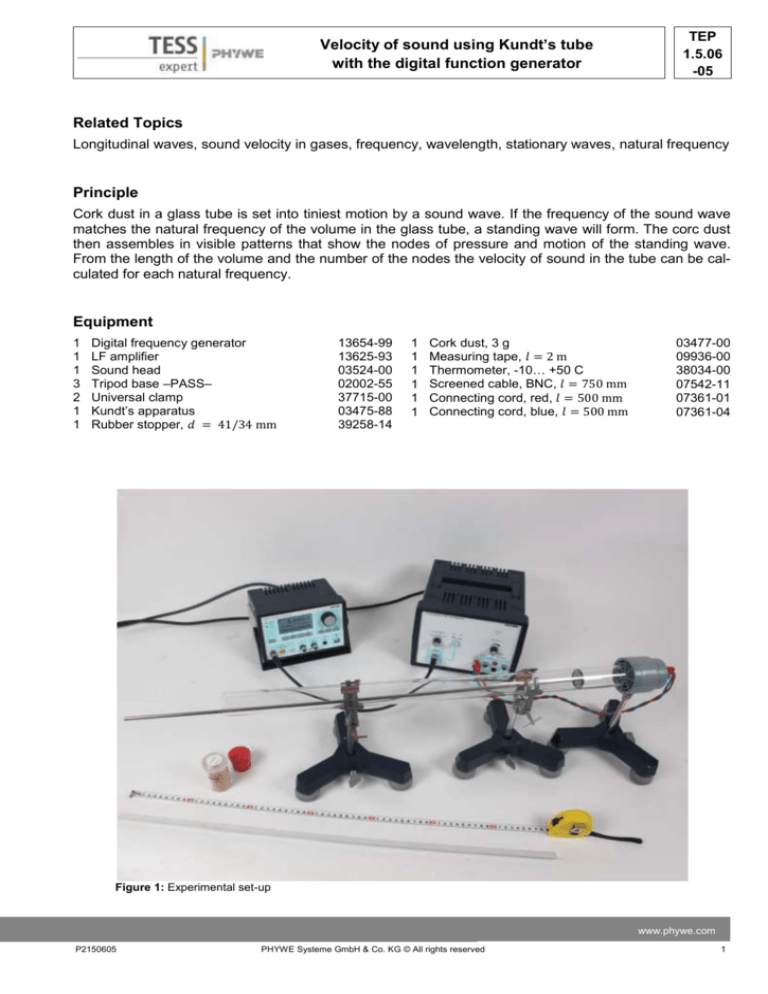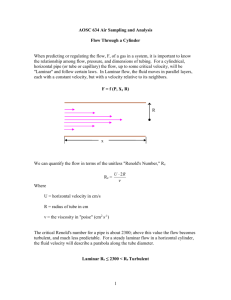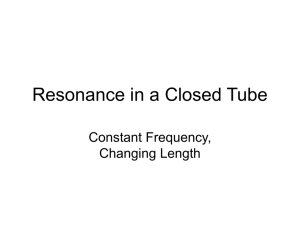
Velocity of sound using Kundt’s tube
with the digital function generator
TEP
1.5.06
-05
Related Topics
Longitudinal waves, sound velocity in gases, frequency, wavelength, stationary waves, natural frequency
Principle
Cork dust in a glass tube is set into tiniest motion by a sound wave. If the frequency of the sound wave
matches the natural frequency of the volume in the glass tube, a standing wave will form. The corc dust
then assembles in visible patterns that show the nodes of pressure and motion of the standing wave.
From the length of the volume and the number of the nodes the velocity of sound in the tube can be calculated for each natural frequency.
Equipment
1
1
1
3
2
1
1
Digital frequency generator
LF amplifier
Sound head
Tripod base –PASS–
Universal clamp
Kundt’s apparatus
Rubber stopper, 𝑑 = 41/34 mm
13654-99
13625-93
03524-00
02002-55
37715-00
03475-88
39258-14
1
1
1
1
1
1
Cork dust, 3 g
Measuring tape, 𝑙 = 2 m
Thermometer, -10… +50 C
Screened cable, BNC, 𝑙 = 750 mm
Connecting cord, red, 𝑙 = 500 mm
Connecting cord, blue, 𝑙 = 500 mm
03477-00
09936-00
38034-00
07542-11
07361-01
07361-04
Figure 1: Experimental set-up
www.phywe.com
P2150605
PHYWE Systeme GmbH & Co. KG © All rights reserved
1
TEP
1.5.06
-05
Velocity of sound using Kundt’s tube
with the digital function generator
Tasks
Determine the velocity of sound in air using Kundt’s tube at different lengths of volume.
Set-up
Perform the experimental set-up according to Fig. 1. Use the charging strip to distribute the cork dust
over the glass tube. Choose either the piston or the rubber stopper to close one end of the glass tube. At
the other end, set up the sound head in such manner, that the center of the sound head is in line with the
center of the tube’s cross sectional area. This way most of the sound will enter the tube and the amplification will stay bearable.
Connect the digital function generator via the screened cable with the low frequency amplifier. The
sound head is connected to the amplifier’s signal output via the connecting cords. Set the amplifier scale
on 100 and set the digital frequency generator to an amplitude of 3 to 5 V and choose a sinusoidal signal
and signal-type out.
Note: If either the glass tube or the cork dust are damp, this experiment cannot work properly. To dry the
dust or the glass tube you can carefully heat them up in an oven to a maximum of 60 °C and bake them
out.
Procedure
Determine the velocity of sound in air. In order to do that count the number of nodes for different natural
frequencies for an open ended as well as a closed volume. For better statistics use the piston to examine at least two different lengths of volume.
To find the natural frequencies, start from 0 Hz and go up to maximum 4000 Hz in steps of 100 Hz. If no
patterns become visible, increase the amplification factor, the maximum of amplification should be factor
101. If you select an amplification factor higher than 101 you may blow the sound head.
When first patterns start to show increase the frequency more slowly in steps of 10 Hz until the pattern
doesn’t wiggle anymore. When the whole pattern throughout the glass tube is absolutely static you found
the natural frequency and generated a standing wave. Note down the number of nodes and the frequency before you continue to the next natural frequency. For each volume length find at least three natural
frequencies for the open ended and the closed standing wave respectively.
Measure the room temperature during the experiment and note it down for later correction of the results.
Theory
The distance between two nodes of a standing wave is half its wavelength in case of parallel
propagation of the waves, which can be assumed for this experiment. Therefore the wavelength for each natural frequency can easily be determined and the frequency can be read
directly from the digital function generator’s display. Keeping in mind that the period 𝑇 is the
inverse of frequency
𝑇 = 1⁄𝜈
(1)
and the wavelength is obtained from
𝜆 = 𝑐⁄𝜈 = 𝑐 ∙ 𝑇
(2)
the sound speed can be found as the slope of the plot of wavelength vs. period.
2
PHYWE Systeme GmbH & Co. KG © All rights reserved
P2150605
TEP
1.5.06
-05
Velocity of sound using Kundt’s tube
with the digital function generator
Alternatively the wavelength can be calculated from
the total number of nodes 𝑛 and the length of the volume 𝐿. For standing waves with one open end we obtain equation (3).
𝜆 = 4 𝐿⁄2𝑛 + 1
(3)
For two open ends one finds the wavelength from (4).
𝜆 = 2𝐿⁄𝑛
(4)
Tab. 1: Measured values for different tube lengths L.
L = 615 mm
n
𝜈 in Hz
990
1250
2000
2250
2500
3000
3750
3
4
7
8
9
11
13
L = 350 mm
n
𝜈 in Hz
1150
1600
2250
2700
3200
3654
2
3
4
5
6
7
Sound propagates in gases with varying speed depending on the gas temperature 𝑇𝑔𝑎𝑠 . From the
equation of state for ideal gases one can derive the
following relation
𝑐 ∝ √𝑇𝑔𝑎𝑠 .
Comparison of sound speeds for different temperatures 𝑇𝑔𝑎𝑠 and 𝑇’𝑔𝑎𝑠 leads to:
𝑇𝑔𝑎𝑠
𝑐 = 𝑐′ ⋅ √
𝑇′𝑔𝑎𝑠
(5)
Evaluation and results
Fig. 4: Measurements for L = 615 mm
In the following the evaluation of the obtained values is
described with the help of example values. Your results may vary from those presented here.
Measurements with the plugged tube for two different
volume lengths are shown in Table 1.
From Figs. 4 and 5 and equation (2) we obtain the
sound speed with 336 m/s and 330 m/s respectively.
The temperature during measurements was 19 ° C.
In the literature a value of 𝑐 = 343 m/s is given for
room temperature of 20°C.
Utilizing equation (5) the experimental velocity of
sound at 20 °C is obtained as 345 m/s and 339 m/s
respectively.
Fig. 5: Measurements for L = 350 mm
www.phywe.com
P2150605
PHYWE Systeme GmbH & Co. KG © All rights reserved
3
TEP
1.5.06
-05
4
Velocity of sound using Kundt’s tube
with the digital function generator
PHYWE Systeme GmbH & Co. KG © All rights reserved
P2150605









